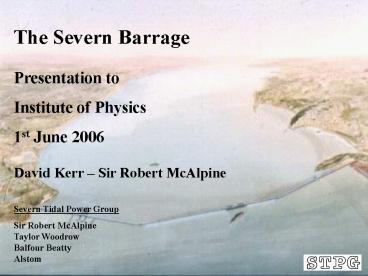The Severn Barrage - PowerPoint PPT Presentation
1 / 34
Title:
The Severn Barrage
Description:
David Kerr Sir Robert McAlpine. Severn Tidal Power Group. Sir Robert ... Downstream of Cardiff to Weston-super-Mare. 16 km length. 4 ... A more stable seabed ... – PowerPoint PPT presentation
Number of Views:93
Avg rating:3.0/5.0
Title: The Severn Barrage
1
The Severn Barrage Presentation to Institute of
Physics 1st June 2006 David Kerr Sir Robert
McAlpine Severn Tidal Power Group Sir Robert
McAlpineTaylor WoodrowBalfour BeattyAlstom
2
Content of Presentation 1. Project Outline 2.
Electricity Generation Demand 3. Environmental
Effects 4. Flood Protection 4. Transport
Aspects 5. Construction Methods and Employment 6.
Economics of the Project 7. Conclusion
3
- Location
- Bristol Channel/ Severn Estuary
- Downstream of Cardiff to Weston-super-Mare
- 16 km length
4
Bondi study (EP46 - 1981) was the first major
studyTripartite study (EP57 - 1989) defined the
present schemeCould produce power by 2017 if
progressed soon
History of Severn Tidal Power Studies
5
Tidal Power
- The Barrage impounds the tide, then the water
is released through a turbine to generate
electricity - Proven Technology La Rance in France has
generated tidal power reliably for over 35 years
6
Barrage Operation
7
Barrage Layout (1989 Report)
- 216 Turbines, 40MW each, 8640MW total
- 166 Sluices 35,000m2
- Ship Locks
- Small Locks
- Public Road
8
Flow Patterns with Barrage
9
Facts and Figures
- Annual Output 17 TWh (5 of UK consumption)
- Installed Capacity 8640 MW
- Savings of CO2 emissions 15Mt per year
compared to Coal (equivalent to 3 of total
UK Carbon emissions) - Renewables Obligation
- 15 by 2015 (50-55TWh) - Barrage cannot
contribute - 20 by 2020 would require a further 17TWh.
Barrage could contribute all of this - if
sanctioned soon - Capital Cost 8Bn 1989 gt 14Bn 2005 needs
re-estimate - Security of supply benefit
10
Energy Generation (Spring Tide)
11
Energy Generation (Neap Tide)
12
Flexibility of Output
13
Modes of operation Ebb Generation Preferred for
Severn ( for most other tidal barrages) Flood
Generation Less usable water volume Two Way
Generation No extra Energy Higher cost of Energy
due to more complex turbines Energy is spread
over more of the day
14
Storage Possibilities
2nd Basin option from Bondi Report of 1975
15
- Environmental Studies 1989
- A total of 70 studies, with a budget of 2M,
covering - Hydrodynamics (tides, currents, waves)
- Sediments, Salinity, Water Quality, Drainage
- Ecology, Birds, Fish
16
Existing Estuary Environment
- Tide Range 14m on springs, 7m on neaps
- High tidal currents large inter-tidal areas
- 30Mt sediment suspended on springs, 4Mt on neaps
- Little sunlight penetration through the water
column - Low dissolved oxygen levels
- Ecology
- Harsh regime
- Very little life on the seabed
- Bird numbers per sq km lower than other
estuaries but still substantial because of the
large total area
17
Sediment Types
Rock Gravel Sandy Area -5m OD Contour
Line Muddy Area
18
- The Changing Environment
- Climate Change
- Temperature rise effects on ecology and birds
- Sea level rise flooding
- Water Quality
- Cleaner Sewage Discharges
- Reduction in Nutrients effect on birds
- Legislation
- Requires assessment against the present
environment inappropriate for such a long term
project should be assessed against the
predicted future environment
19
Main effects of the Barrage
- Tide Range reduced from 14m to 7m (springs)
- A smaller inter-tidal area upstream of barrage
- Reduced currents, leading to-
- A large reduction in suspended sediment
- Sunlight penetration through the water column
- An increase in dissolved oxygen to more normal
levels - A more stable seabed
- Expected to result in colonisation by a wider
range of estuarine organisms and an increase in
most bird species and numbers
20
Areas at Risk from Flooding
21
Flood protection in the Severn Estuary and Rivers
- Flooding in the estuary can occur when extreme
high tides coincide with storm surges - Flooding in the rivers can occur when these
same sea conditions coincide also with high river
flows - The water level in the basin can be controlled
- - To prevent the flooding in the estuary (upstream
of the barrage) - To avoid obstruction to river flow caused by
high tides
22
Use Of Barrage for Flood Protection
23
Environmental Balance ?
- Loss of the unique harsh environment
- Some birds (Dunlin) will lose part of their
habitat - Marine life and most bird species will increase
- Flood protection to estuary and rivers
- Carbon Saving
- The environmental assessment needs to be updated
to account for the changes in the Estuary since
the 1980s, predicted future changes and the
changes in legislation
24
Transport Key Issues
- Ports and Shipping
- Forecast Shipping Movements
- Size of Locks to suit Avonmouth docks
- Road and Rail
- Cost-benefit of a Barrage Crossing
25
Construction Prefabricated Caissons
26
- Caisson Construction Sites
- 1989 report identified potential UK sites shown
- Potential Sites in Europe
- Project and Employment Benefits of using many
Sites
27
Construction Sequence (1989 Report)
28
Turbine Installation
29
9m Diameter Bulb Turbine
30
Employment(1989 report)
- 200,000 man years for construction
- 35,000 jobs at construction peak, distributed
over the UK, about half in the Severnside
region - 10,000 - 40,000 permanent jobs in the region
31
Cost Price relationship
ROC recycle ROC buyout Wholesale electricity
price
p/kWh April 2005 money
32
Value of Externalities
These indicative values are a key part of the
project value
p/kWh
33
Outline Programme for Implementation
34
Conclusion
The Severn Barrage should be re-assessed as part
of the Energy Review































